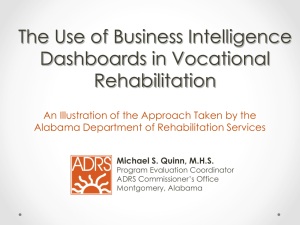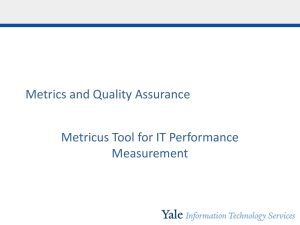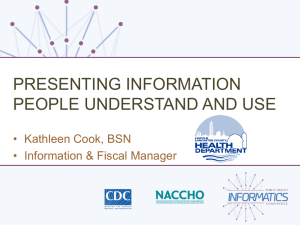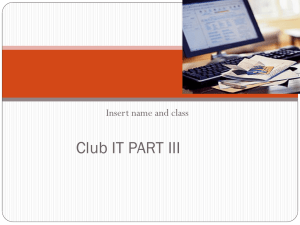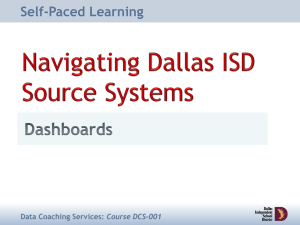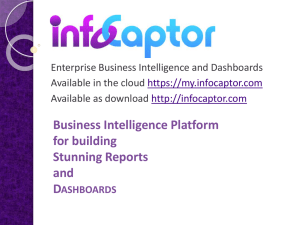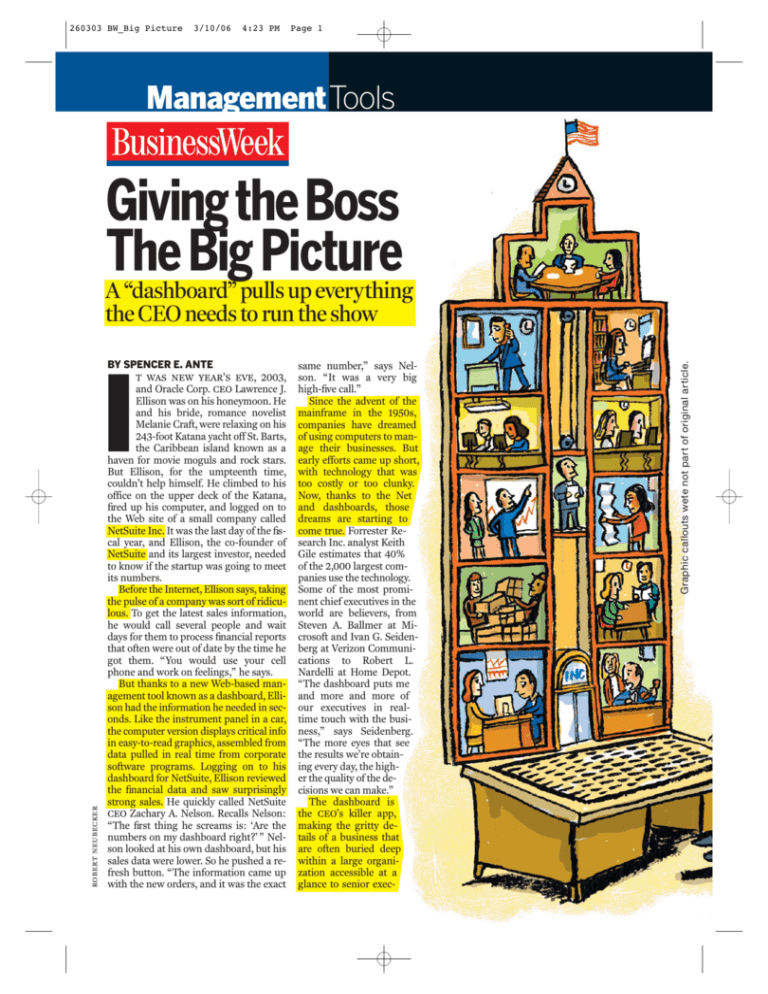
260303 BW_Big Picture
3/10/06
4:23 PM
Page 1
Management Tools
Giving the Boss
The
Big
Picture
A “dashboard” pulls up everything
BY SPENCER E. ANTE
t was new year’s eve, 2003,
and Oracle Corp. ceo Lawrence J.
Ellison was on his honeymoon. He
and his bride, romance novelist
Melanie Craft, were relaxing on his
243-foot Katana yacht off St. Barts,
the Caribbean island known as a
haven for movie moguls and rock stars.
But Ellison, for the umpteenth time,
couldn’t help himself. He climbed to his
office on the upper deck of the Katana,
fired up his computer, and logged on to
the Web site of a small company called
NetSuite Inc. It was the last day of the fiscal year, and Ellison, the co-founder of
NetSuite and its largest investor, needed
to know if the startup was going to meet
its numbers.
Before the Internet, Ellison says, taking
the pulse of a company was sort of ridiculous. To get the latest sales information,
he would call several people and wait
days for them to process financial reports
that often were out of date by the time he
got them. “You would use your cell
phone and work on feelings,” he says.
But thanks to a new Web-based management tool known as a dashboard, Ellison had the information he needed in seconds. Like the instrument panel in a car,
the computer version displays critical info
in easy-to-read graphics, assembled from
data pulled in real time from corporate
software programs. Logging on to his
dashboard for NetSuite, Ellison reviewed
the financial data and saw surprisingly
strong sales. He quickly called NetSuite
ceo Zachary A. Nelson. Recalls Nelson:
“The first thing he screams is: ‘Are the
numbers on my dashboard right?’ ” Nelson looked at his own dashboard, but his
sales data were lower. So he pushed a refresh button. “The information came up
with the new orders, and it was the exact
robert neubecker
I
same number,” says Nelson. “It was a very big
high-five call.”
Since the advent of the
mainframe in the 1950s,
companies have dreamed
of using computers to manage their businesses. But
early efforts came up short,
with technology that was
too costly or too clunky.
Now, thanks to the Net
and dashboards, those
dreams are starting to
come true. Forrester Research Inc. analyst Keith
Gile estimates that 40%
of the 2,000 largest companies use the technology.
Some of the most prominent chief executives in the
world are believers, from
Steven A. Ballmer at Microsoft and Ivan G. Seidenberg at Verizon Communications to Robert L.
Nardelli at Home Depot.
“The dashboard puts me
and more and more of
our executives in realtime touch with the business,” says Seidenberg.
“The more eyes that see
the results we’re obtaining every day, the higher the quality of the decisions we can make.”
The dashboard is
the ceo’s killer app,
making the gritty details of a business that
are often buried deep
within a large organization accessible at a
glance to senior exec-
Graphic callouts wete not part of original article.
the CEO needs to run the show
260303 BW_Big Picture
3/10/06
4:23 PM
Page 2
PLAYBOOK: BEST-PRACTICE IDEAS
How to Score Points with a Dashboard
A dashboard is software
that’s used to present
corporate information,
such as sales data
and customer service
requests, on a PC in
colorful graphics,
just like the
speedometer of a car.
Here are a few
tips for making your
dashboard a success:
1. START SLOWLY
3. BUSINESS SHOULD DRIVE
Do not ram a dashboard down
employees’ throats. It can be seen as a
tool that threatens their privacy or
autonomy. In the beginning, it’s wise
to highlight organizational performance instead of individual
performance.
Some corporations allow their tech team
to oversee a dashboard project. This is a no-no.
Managers and employees should guide the
development, in conjunction with the techies.
2. PICK THE RIGHT INFO
A dashboard is only as useful as
the data behind it. That’s why it’s
crucial to invest time up front
identifying the most important metrics.
Without the critical info, the system
won’t be used.
utives. So powerful are the programs that
they’re beginning to change the nature of
management, from an intuitive art into
more of a science. Managers can see key
changes in their businesses almost instantaneously—when salespeople falter
or quality slides—and take quick, corrective action. At Verizon, Seidenberg and
other executives can choose from among
300 metrics to put on their dashboards,
from broadband sales to wireless subscriber defections. At General Electric
Co., James P. Campbell, chief of the Consumer & Industrial division, which
makes appliances and lighting products,
tracks the number of orders coming in
from each customer every day and compares that with targets. “I look at the digital dashboard the first thing in the
morning so I have a quick
global view of sales and
service levels across
the organization,” says
Campbell. “It’s a key
operational tool in
our business.”
4. AVOID DATA OVERKILL
Displaying too much data may overwhelm
and lead to micromanagement. Pick the six or
seven most important metrics to show.
5. KEEP A PERSONAL TOUCH
Dashboards can be powerful tools to run your
business, but don’t spend all your time staring at
the computer screen. Walking around and talking
to workers will be at least as important.
The technology is particularly valuable to small companies, since most of
them couldn’t afford sophisticated software in the past. Up until about five
years ago, dashboards had to be custom
built, so the expense could run into the
millions of dollars. Now, NetSuite and
others offer products that run $1,000
to $2,000 a year per user. “NetSuite
brought on a total change in the way
the company works and thinks,” says
Nate Porter, vice-president of American
Reporting Co., a Kirkland (Wash.)
provider of credit reports and other
mortgage services.
PRIVACY CONCERNS
still, dashboards have drawn some
flak. Critics say ceos can miss the big
picture if they’re glued to their computer
screens. ge agrees with that point.
While business unit chiefs such as
Campbell are active dashboard users,
ceo Jeffrey Immelt is not, since he focuses on issues such as broad strategy
and dealmaking that the technology
can’t yet capture.
Other critics fear dashboards are an alluring but
destructive force, the latest
incarnation of Big Brother.
The concern is that companies will use the technology
to invade the privacy of
workers and wield it as a
whip to keep them in line.
Even managers who use
dashboards admit the tools
can raise pressure on
employees, create divisions
in the office, and lead workers to hoard
information.
One common concern is that dashboards can hurt morale. Consider the case
of Little Earth Productions Inc., a Pittsburgh clothing manufacturer. The company uses NetSuite’s tools to monitor the
amount of business each salesperson has
brought in and then displays it publicly.
“You do feel bummed out sometimes if
you are low on the list,” says Ronisue
Koller, a Little Earth salesperson.
Those pressures can lead to even bigger disruptions. NetSuite ceo Nelson
says his dashboard allows him to read
every e-mail sent by the sales staff and to
inspect the leads of each salesperson.
“It’s frightening,” he says. And it can
have serious consequences. Once a
month, Nelson plays “lead fairy” and
looks at what sales leads have been followed up on and which ones haven’t.
One salesman quit when Nelson wrested
away his sales leads that were not being
used and gave them to others who were
out of leads. “This raised enormous
hackles in the company,”
says Nelson. “That’s fine
with me because he wasn’t
doing his job anyway.”
Still, most management
experts think the rewards
are well worth the risks.
They caution that executives should roll out the
systems slowly and avoid
highlighting individual
performance, at least at
first. They also underscore
the need for business lead-
Now the
CEO can
read every
e-mail sent
by the sales
staff
260303 BW_Big Picture
3/10/06
4:23 PM
Page 3
Management Tools
A MUST-HAVE
netsuite, based in San Mateo,
Calif., was founded in 1998 by Ellison and Evan Goldberg, a former top
software engineer at Oracle. In
2002, Nelson took over the company
after leaving Network Associates.
Today the company offers everything
from dashboards to marketing software to tools for setting up an ecommerce Web site. NetSuite claims
more than 7,000 customers, most of
them small and midsize businesses.
In 2005, it was the second-fastestgrowing technology company in
North America based on five-year
sales growth, according to consultant Deloitte. And last year it was on
track to hit $70 million in sales, up
from $41 million in 2004.
One big fan of dashboards is Microsoft Corp., which of course
makes plenty of business software
itself. Jeff Raikes, president of the
Microsoft division that makes its
Microsoft Office software, says that
more than half of its employees use
dashboards, including Ballmer and
What’s On Your
Dashboard?
Steve Ballmer
MICROSOFT
Ballmer requires his top
officers to bring their
dashboards with them
into one-on-one meetings.
Ballmer zeroes in on such
metrics as sales,
customer satisfaction,
and status of key products
under development.
chief software architect William H.
Gates III. “Every time I go to see
Ballmer, it’s an expectation that I
bring my dashboard with me,” says
Raikes. Ballmer, he says, reviews
the dashboards of his seven business heads during one-on-one
meetings, zeroing in on such metrics as sales, customer satisfaction,
and the status of key products under development.
As for Gates, Raikes says the Microsoft founder uses a dashboard
during his “think week,” when he
leaves the office and reads more than
100 papers about the tech industry
prepared by employees. “He uses the
dashboard to track what he has read
and the feedback and actions that
should be taken,” says Raikes.
Ivan Seidenberg
TROUBLESHOOTING
VERIZON
dashboards are a natural for
monitoring operations. In manufacturing, ge execs use them to follow
the production of everything from
lightbulbs to dishwashers, making
sure production lines are running
smoothly. In the software business,
Raikes uses his dashboard to track
the progress of the upcoming version of Office. Shaygan Kheradpir,
the chief information officer at Verizon, has on his dashboard what coworkers call the Wall of Shaygan, a
replica of every single node on the
telecom giant’s network. All green is
good. Yellow or red merits a click.
Red means an outage somewhere.
“It makes you move where you need
to move,” he says.
Dashboard technology can help
keep customers happy, too. Before
NetSuite, American Reporting’s
Porter says customer-service reps
just answered the phone and had no
place to store client requests. Now
the company’s entire customerservice team uses the software. As a
result, customer-service managers
can see who is responding to calls.
And service reps have access to every
repair ticket, making it easier to
handle customer problems. “It allows us to compete against some of
the bigger boys,” says Porter.
American Reporting isn’t the only
small fry that’s benefiting. Jerry
Driggs, chief operating office of Little
Earth, took four months last winter
to move his business onto the NetSuite system. Little Earth sells funky
eco-fashion products, such as a
handbag made with recycled license
Seidenberg and others
can choose from more
than 300 metrics to put
on their dashboards, from
broadband sales to
wireless defections.
Managers pick the metrics
they want to track, and the
dashboard flips the pages
24 hours a day.
Jeff Immelt
GENERAL ELECTRIC
Many GE executives use
dashboards to run their
day-to-day operations,
monitoring profits per
product line and fill rates
for orders. Immelt
occasionally looks at a
dashboard. But he relies
on his managers to run the
businesses so he can
focus on the big picture.
Larry Ellison
ORACLE
A fan of dashboards,
Ellison uses them to track
sales activity at the end of
a quarter, the ratio of sales
divided by customer
service requests, and the
number of hours that
technicians spend on the
phone solving customer
problems.
(top to bottom) photographs by norm betts/bloomberg news;
ken cedeno/bloomberg news; andy shaw/bloomberg news; justin sullivan/getty images
ers to spend time up-front figuring
out which metrics are the most useful to track. But that’s a question of
how to use the technology, not
whether to implement it. “You
can’t manage something you can’t
measure,” says Ken Rau, managing
partner at Bay Area Consulting
Group llc in San Francisco.
“Dashboards are one of management’s key techniques to make sure
an organization is performing according to its objectives.”
The intellectual foundation for
dashboards was laid down in the late
1970s with the academic field of decision support systems. dss introduced the idea that computer systems could be used to aid the process
of decision-making. But it wasn’t until the late 1990s, as the Internet
linked up computers around the
world, that companies began building the dashboards of today. In 1998,
ge was one of the first companies to
cobble together its own proprietary
technology. The trend picked up
steam after the recession of 2001,
when efficiency became a priority. In
the past few years, a new wave of
software makers—including NetSuite, Salesforce.com, and Hyperion
Solutions—have begun making
dashboards that are even cheaper
and easier to use.
260303 BW_Big Picture
3/10/06
4:23 PM
Page 4
Management Tools
plates. Today half of the company’s 50
employees use the system to manage
their production, sales, and financial operations. “Once you see it is so intuitive,
you wonder how we ran the business
before,” says Driggs.
In fact, Driggs ran the business by the
seat of his pants, and it showed. Because
the company had no system to measure
its production requirements or level of
raw materials, much of which came from
China, it took about six weeks to make
and ship a handbag. And Little Earth constantly struggled with cash problems
because Driggs would often buy more
trim pieces and twist-knob closures than
he needed. “You used to see dollars sitting on the shelves,” he says. Now, using
NetSuite, Driggs can monitor his purchase orders and inventory levels, and the
system even alerts him when he is run-
ning low on closures and other parts. The
result: Little Earth has slashed its shipping time to three days. “All of those
things that used to drive us crazy are
literally at our fingertips,” says Driggs.
If it’s near the end of a financial quarter, Oracle’s Ellison tracks his customers
like a hawk. “I want to know what our five
biggest deals are three days before the
quarter closes,” he says. “I look at the
[dashboard] several times a day. So much
of our sales activity gets compressed into
a few days.” Ellison will then call the
companies himself or figure out another
way to seal the deal.
Since his honeymoon two years ago,
Ellison has become more convinced than
ever that dashboards are the way of the
future. He just wishes more of his employees thought the way he does. One
continuing frustration is that although
all of Oracle’s 20,000 salespeople use
dashboards, Ellison says some 20% of
them refuse to enter their sales leads into
the system. Salespeople don’t want to
be held accountable for a lead that isn’t
converted into a sale. That makes it hard
to get a true picture of the demand for
Oracle’s products.
Ellison has considered refusing to pay
commissions on a sale if the order is not
entered into a dashboard, but for now he
thinks such a move might prove to be a
bit draconian. “The salespeople are the
last of the independents,” says Ellison.
“They think their Rolodex is private.”
Even Ellison, one of the world’s richest
men, concedes that technology—and the
power it gives him—has it limits.
“People have to be persuaded that it’s
right,” he says. ❚❚
–With Jena McGregor in New York
Reprinted from BusinessWeek, February 13, 2006, copyright by The McGraw-Hill Companies, Inc., with all rights reserved.
This reprint implies no endorsement, either tacit or expressed, of any company, product, service or investment opportunity.


